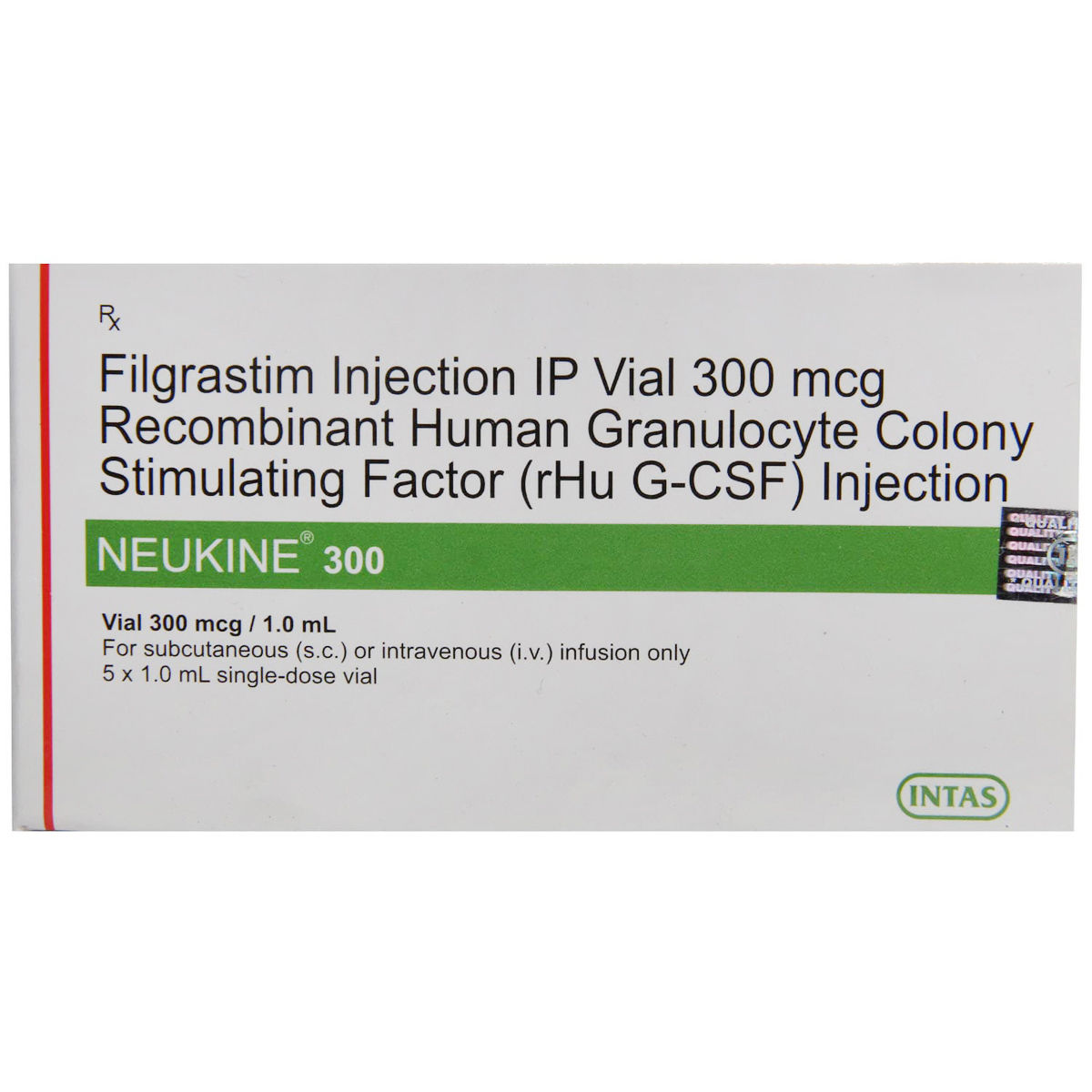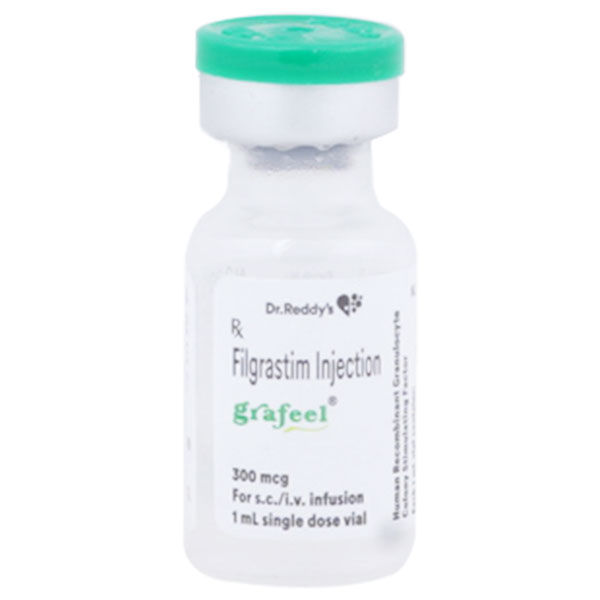Xgrast 300mcg Injection 1's

₹1158.5*
(Inclusive of all Taxes)
This offer price is valid on orders above ₹800. Apply coupon PHARMA10/PHARMA18 (excluding restricted items)
GetFREE deliveryon this order with circle membership
Know Your Delivery Time
Provide Delivery Location
Available Offers
 Prescription drug
Prescription drugWhats That

Secure Payment

India's Most Trusted Pharmacy

Genuine Products
Composition :
Manufacturer/Marketer :
Consume Type :
Return Policy :
Expires on or after :
About Xgrast 300mcg Injection
Xgrast 300mcg Injection belongs to the class of medicine called 'hematopoietic agent' used to treat neutropenia, a lack of certain white blood cells caused by cancer, bone marrow transplant, receiving chemotherapy, bacterial infections or other conditions. Neutropenia is a condition in which the number of neutrophils (a type of white blood cell) in the blood is decreased. White blood cells (neutrophils) protect the body from infections. Without enough neutrophils, the body can not fight off bacteria which increases the risk of many types of infections.
Xgrast 300mcg Injection contains ' Filgrastim ' that stimulates the bone marrow (the tissue where new blood cells are made) to produce more white blood cells that help fight infection. Xgrast 300mcg Injection is used to improve white blood cells during cancer treatment (chemotherapy), bone marrow transplantation, severe chronic neutropenia (low number of a type of white blood cells), neutropenia in patients with HIV infection, and before stem cell donation.
You are advised to take Xgrast 300mcg Injection for as long as your doctor has prescribed it for you, depending on your medical condition. In some cases, you may experience certain common side effects such as thrombocytopenia (low platelets level), anaemia (low red blood cell), headache, diarrhoea, vomiting, nausea, alopecia (unusual hair loss), tiredness, soreness, swelling of the digestive tract, fever. Most of these side effects do not require medical attention and will resolve gradually over time. However, you are advised to talk to your doctor if you experience these side effects persistently.
To treat your condition effectually, continue taking Xgrast 300mcg Injection for as long as your doctor has prescribed. To avoid recurring symptoms, do not stop it midway. Do not take Xgrast 300mcg Injection if you are pregnant or planning for pregnancy. Xgrast 300mcg Injection should not be taken by breastfeeding mothers unless prescribed. Xgrast 300mcg Injection should be given to children under strict medical supervision. Please tell your doctor before using Xgrast 300mcg Injection if you have sickle cell anaemia, as Xgrast 300mcg Injection may cause sickle cell crisis and osteoporosis (bone disease). Regular blood tests will be taken to monitor the number of white blood cells in the body. Inform your doctor about your health condition and medicines to rule out unpleasant side effects. Xgrast 300mcg Injection is a cold chain medicine, and so it has to be stored in the refrigerator between 2-8 degrees celsius else its efficacy might get lost. Do not store in the freezer or the fridge.
Uses of Xgrast 300mcg Injection
Directions for Use
Medicinal Benefits
Xgrast 300mcg Injection contains ‘Filgrastim’ is a white blood cell growth factor. It belongs to a group of proteins called cytokines and is very similar to a natural protein (granulocyte-colony stimulating factor) produced by your body. Xgrast 300mcg Injection works by stimulating the bone marrow (the tissue where new blood cells are made) to produce more white blood cells that help fight infection. Xgrast 300mcg Injection is used to improve white blood cells during cancer treatment (chemotherapy), bone marrow transplantation, severe chronic neutropenia (low number of a type of white blood cells), neutropenia in patients with HIV infection and before stem cell donation.
How Xgrast 300mcg Injection Works
Storage
- Inform your doctor about the nausea and discuss possible alternatives to the medication or adjustments to the dosage.
- Divide your daily food intake into smaller, more frequent meals to reduce nausea.
- Opt for bland, easily digestible foods like crackers, toast, plain rice, bananas, and applesauce.
- Avoid certain foods that can trigger nausea, such as fatty, greasy, spicy, and smelly foods.
- Drink plenty of fluids, such as water, clear broth, or electrolyte-rich beverages like coconut water or sports drinks.
- Use ginger (tea, ale, or candies) to help relieve nausea.
- Get adequate rest and also avoid strenuous activities that can worsen nausea.
- Talk to your doctor about taking anti-nausea medication if your nausea is severe.
- Record when your nausea occurs, what triggers it, and what provides relief to help you identify patterns and manage your symptoms more effectively.
- Preventing Vomiting (Before it Happens)
- Take medication exactly as prescribed by your doctor. This can help minimize side effects, including vomiting.
- Having a small meal before taking your medication can help reduce nausea and vomiting.
- Talk to your doctor about taking anti-nausea medication along with your prescribed medication.
- Managing Vomiting (If it Happens)
- Try taking ginger in the form of tea, ale, or candy to help alleviate nausea and vomiting.
- What to Do if Vomiting Persists
- Consult your doctor if vomiting continues or worsens, consult the doctor for guidance on adjusting your medication or additional treatment.
- Regular exercise, like swimming, walking, and yoga, can help reduce bone pain by strengthening muscles and releasing natural pain relievers.
- Physical therapy, including stretching, strengthening exercises, TENS (a type of therapy using electrical pulses), and massage, can help ease bone pain and improve movement.
- Mind-body techniques, like relaxation, meditation, and hypnosis, can reduce pain and help control muscle tension that comes with bone pain.
- Acupuncture may help reduce bone pain by triggering the release of natural painkillers and easing nerve discomfort.
- Avoid sitting for long periods; take short walks or stretch regularly.
- Herbs like turmeric and ginger might help with bone pain.
- Eat a diet rich in calcium, vitamin D, and protein for strong bones and muscles.
- Quit smoking and limit alcohol.
- Eat protein-rich foods like fish, poultry, eggs, and legumes.
- Include foods with minerals and vitamins essential for hair health.
- Join a support group to connect with others experiencing hair loss.
- Openly discuss your feelings about hair loss.
- Consider covering up with wigs, hats, or scarves.
- Be patient and avoid seeking miracle cures.
- Inform Your Doctor: Notify your doctor immediately about your diarrhoea symptoms. This allows them to adjust your medication or provide guidance on managing side effects.
- Stay Hydrated: Drink plenty of fluids to replace lost water and electrolytes. Choose water, clear broth, and electrolyte-rich drinks. Avoid carbonated or caffeinated beverages to effectively rehydrate your body.
- Follow a Bland Diet: Eat easy-to-digest foods to help firm up your stool and settle your stomach. Try incorporating bananas, rice, applesauce, toast, plain crackers, and boiled vegetables into your diet.
- Avoid Trigger Foods: Steer clear of foods that can worsen diarrhoea, such as spicy, fatty, or greasy foods, high-fibre foods, and dairy products (especially if you're lactose intolerant).
- Practice Good Hygiene: Maintain good hygiene to prevent the spread of infection. To stay healthy, wash your hands frequently, clean and disinfect surfaces regularly, and avoid exchanging personal belongings with others.
- Take Anti-Diarrheal Medications: If your doctor advises, anti-diarrheal medications such as loperamide might help manage diarrhoea symptoms. Always follow your doctor's directions.
- Keep track of your diarrhoea symptoms. If they don't get better or worse or are accompanied by severe stomach pain, blood, or dehydration signs (like extreme thirst or dark urine), seek medical help.
- Inform your doctor immediately if you experience a fever after starting a new medication.
- Your doctor may adjust your medication regimen or dosage as needed to minimize fever symptoms.
- Monitor your body temperature to monitor fever progression.
- Drink plenty of fluids, such as water or electrolyte-rich beverages, to help your body regulate temperature.
- Get plenty of rest and engage in relaxation techniques, such as deep breathing or meditation, to help manage fever symptoms.
- Under the guidance of your doctor, consider taking medication, such as acetaminophen or ibuprofen, to help reduce fever.
- If your fever is extremely high (over 103°F), or if you experience severe symptoms such as confusion, seizures, or difficulty breathing, seek immediate medical attention.
- Rest well; get enough sleep.
- Eat a balanced diet and drink enough water.
- Manage stress with yoga and meditation.
- Limit alcohol and caffeine.
- Physical activities like walking or jogging might help boost energy and make you feel less tired.
What if I have taken an overdose of Xgrast 300mcg Injection
Drug Warnings
Do not take Xgrast 300mcg Injection if you are allergic to Xgrast 300mcg Injection or any of its ingredients it may contain inactive ingredients (such as dry natural rubber/latex in the needle cover on the prefilled syringe), which can cause allergic reactions or other problems. Before starting treatment with Xgrast 300mcg Injection, inform your doctor if you have sickle cell anaemia, osteoporosis (bone disease), kidney disease, liver disease, spleen problems, heart problems, and radiation treatment. Xgrast 300mcg Injection can cause the spleen to become enlarged, and it could rupture (tear). Inform your doctor right away if you have sudden or severe pain in your left upper stomach spreading up to your shoulder. If you receive chemotherapy or bone marrow transplant, do not use Xgrast 300mcg Injection within 24 hours before or 24 hours after you receive chemotherapy or bone marrow transplant. Do not take Xgrast 300mcg Injection if you are pregnant or breastfeeding unless prescribed by the doctor. Xgrast 300mcg Injection can be given safely to children only when prescribed. Xgrast 300mcg Injection may cause dizziness, so drive only if you are alert. Avoid consuming alcohol along with Xgrast 300mcg Injection as it could lead to increased drowsiness. Keep your doctor informed about all the medicines you are taking, including prescription, non-prescription medicines and herbal supplements.
Drug-Drug Interactions
Drug-Drug Interactions
Login/Sign Up
Coadministration of Xgrast 300mcg Injection with Azacitidine can reduce the effects of Xgrast 300mcg Injection.
How to manage the interaction:
Although there is an interaction between Xgrast 300mcg Injection and azacitidine, they can be taken together if prescribed by a doctor. Do not discontinue any medications without consulting a doctor.
Taking Xgrast 300mcg Injection together with olaparib can reduce the effects of Xgrast 300mcg Injection.
How to manage the interaction:
Co-administration of Xgrast 300mcg Injection with Olaparib can possibly result in an interaction, but it can be taken if your doctor has advised it. Do not discontinue any medications without first consulting your doctor.
Coadministration of Xgrast 300mcg Injection with Bexarotene can alter the effect of Xgrast 300mcg Injection.
How to manage the interaction:
Although there is an interaction between Xgrast 300mcg Injection and bexarotene, they can be taken together if prescribed by a doctor. Do not discontinue any medications without consulting a doctor.
Combining Xgrast 300mcg Injection with Bleomycin can increase the risk of developing lung disorders.
How to manage the interaction:
There may be a possibility of interaction between Xgrast 300mcg Injection and Bleomycin, it can be taken if prescribed by a doctor. Do not stop using any medications without a doctor's advice.
Using Xgrast 300mcg Injection together with lenalidomide can reduce the effect of Xgrast 300mcg Injection.
How to manage the interaction:
Co-administration of Xgrast 300mcg Injection with Lenalidomide can possibly result in an interaction, but it can be taken if your doctor has advised it. Do not discontinue any medications without consulting a doctor.
Using Xgrast 300mcg Injection together with mitomycin reduce the effects of Xgrast 300mcg Injection.
How to manage the interaction:
Co-administration of Xgrast 300mcg Injection with Mitomycin can result in an interaction, but it can be taken if a doctor has advised it. Do not discontinue any medications without consulting a doctor.
Taking Xgrast 300mcg Injection together with Imatinib can reduce the effect of Xgrast 300mcg Injection.
How to manage the interaction:
There may be a possibility of interaction between Xgrast 300mcg Injection and Imatinib, but it can be taken if prescribed by a doctor. Do not discontinue any medications without consulting a doctor.
Co-administration of Xgrast 300mcg Injection together with Mercaptopurine can reduce the effects of Xgrast 300mcg Injection.
How to manage the interaction:
Although taking Xgrast 300mcg Injection and Mercaptopurine together can cause an interaction, it can be taken if a doctor has suggested it. Do not stop using any medications without a doctor's advice.
Coadministration of Xgrast 300mcg Injection with Busulfan can reduce the effects of Xgrast 300mcg Injection.
How to manage the interaction:
Although there is a possible interaction between Xgrast 300mcg Injection and Busulfan, you can take these medicines together if prescribed by your doctor. Do not stop using any medications without talking to your doctor.
Coadministration of Xgrast 300mcg Injection with Brentuximab can decrease the therapeutic effect of Xgrast 300mcg Injection.
How to manage the interaction:
Although there is an interaction between Xgrast 300mcg Injection and brentuximab, they can be taken together if prescribed by a doctor. Do not discontinue any medications without consulting a doctor.
Drug-Food Interactions
Drug-Food Interactions
Login/Sign Up
Diet & Lifestyle Advise
Eat a well-balanced and healthy diet, as it helps you to recover quickly. A dietitian will help you to create a diet plan based on your health condition.
Avoid eating raw or undercooked food.
Eat food rich in antioxidants such as berries, spinach, kidney beans, dark chocolate, etc.
Foods containing flavonoids help in reducing inflammation. These include soy, berries, broccoli, grapes, and green tea.
Limit alcohol consumption and quit smoking.
Habit Forming
Therapeutic Class
Xgrast 300mcg Injection Substitute

Neukine 300 Injection 1 ml
by Others
₹554.40per tabletGrafeel Injection 1 ml
by Others
₹695.30per tabletNeukine 300 mcg Injection 1 ml
by Others
₹1169.10per tabletAxokine Injection 1 ml
by AYUR
₹1152.00per tabletEmgrast 300 mcg Injection 0.5 ml
by Others
₹1169.10per tablet
Product Substitutes
Alcohol
Caution
Avoid alcohol consumption while taking Xgrast 300mcg Injection. It could lead to increased dizziness and drowsiness.
Pregnancy
Caution
It is not known whether this Xgrast 300mcg Injection will harm an unborn baby. Inform your doctor if you are pregnant or plan to become pregnant.
Breast Feeding
Caution
It is unknown whether Xgrast 300mcg Injection passes over into the breast milk. Please inform your doctor if you are breastfeeding before taking Xgrast 300mcg Injection.
Driving
Caution
Xgrast 300mcg Injection may cause dizziness, drowsiness, and tiredness; do not drive or operate heavy machinery if you feel dizzy.
Liver
Caution
If you have liver problems, inform your doctor before receiving Xgrast 300mcg Injection. Your doctor may adjust the dose based on your condition or prescribe a suitable alternative.
Kidney
Caution
Xgrast 300mcg Injection should be used with caution in patients with kidney diseases. Dose adjustments may be necessary. In some case, Xgrast 300mcg Injection cause kidney injury. Inform your doctor immediately if you experience puffiness in your face or ankles, blood in your urine, or brown-coloured urine, or you notice you urinate less than usual.
Children
Safe if prescribed
Xgrast 300mcg Injection is used to treat children who are receiving chemotherapy or who suffer from severe low white blood cell count (neutropenia). The doctor will decide the dose of Xgrast 300mcg Injection based on the age, body weight and condition of your child.
FAQs
Xgrast 300mcg Injection is used to treat neutropenia (lack of certain white blood cells) caused by cancer, bone marrow transplant, chemotherapy, bacterial infections or other conditions.
Xgrast 300mcg Injection contains 'Filgrastim' is a growth factor that stimulates the bone marrow to produce white blood cells. These cells protect the body against infections.
No, Xgrast 300mcg Injection is not recommended to patients with spleen disorder. It may cause your spleen to become enlarged, and it could rupture. If you experience pain in the left upper stomach/abdominal area or left shoulder, contact your doctor immediately.
If you are being treated for severe chronic neutropenia for a longer period, Xgrast 300mcg Injection may cause blood in your urine (haematuria). Your doctor may regularly test your urine if you experience this side effect or if a protein is found in your urine (proteinuria).
Xgrast 300mcg Injection should be used with caution in patients with kidney diseases. Dose adjustments may be necessary. Xgrast 300mcg Injection cause breathlessness (dyspnoea), tachycardia & wheeze, and even death. If you have had a history of asthma, the more possibility of these systemic allergic-like reactions. Please inform your doctor.
Xgrast 300mcg Injection to be taken with caution, especially if you have had heart problems. The dose may have to be adjusted by your doctor. In some cases, Xgrast 300mcg Injection causes inflammation of the aorta (the large blood vessel which transports blood from the heart to the body) symptoms can include fever, abdominal pain, malaise, back pain, and increased inflammatory markers. Tell your doctor if you experience those symptoms. Please inform your doctor before taking Xgrast 300mcg Injection.
Yes, Xgrast 300mcg Injection may interfere with certain lab tests such as bone imaging and blood tests (elevation in lactate dehydrogenase and alkaline phosphate), possibly causing false test results. Make sure your doctor and laboratory staff know you use Xgrast 300mcg Injection.
Xgrast 300mcg Injection is generally safe when used as prescribed by your doctor. However, like all medications, it can cause side effects, some of which may be serious. Common side effects are usually mild and temporary. Still, following your doctor's instructions and attending regular check-ups to monitor your health is essential. If you experience any unusual or persistent symptoms, contact your doctor promptly. Additionally, inform your doctor about your medical history, allergies, and other medications to minimize the risk of adverse reactions. You can minimize potential risks and ensure safe treatment by using Xgrast 300mcg Injection as directed and under medical supervision.
There is no clear evidence that Xgrast 300mcg Injection causes cancer. Sharing your medical history and risk factors with your doctor is crucial. They'll explain the benefits and potential risks of taking Xgrast 300mcg Injection, including any long-term effects. If you have concerns about cancer or other health issues, consult your doctor or a qualified healthcare professional for personalized advice.
Xgrast 300mcg Injection stimulates the bone marrow to generate a large number of white blood cells, which might cause bone pain. This pain is frequently felt in the bones of the thighs, hips, and upper arms. The pain is usually temporary and resolves once treatment is stopped or the dose is adjusted. Inform your doctor if you are experiencing heavy pain, and your doctor may prescribe medications to manage discomfort.
Xgrast 300mcg Injection is used to treat children receiving chemotherapy or suffering from severe low white blood cell count (neutropenia). The doctor will decide the dose of Xgrast 300mcg Injection based on your child's age, body weight and condition. Follow your doctor's directions to achieve better results.
Xgrast 300mcg Injection should be used with caution if you have kidney disease. It may increase the risk of kidney problems, so your doctor will monitor you closely. They may adjust your dose or watch for signs of kidney issues. If you have kidney disease, tell your doctor before taking Xgrast 300mcg Injection, and they'll help you use it safely.
Xgrast 300mcg Injection may cause dizziness, drowsiness, and tiredness.do not drive or operate heavy machinery if you feel dizzy.
Common side effects of Xgrast 300mcg Injection may include thrombocytopenia (low platelets level), anaemia (low red blood cell), headache, diarrhoea, vomiting, nausea, alopecia (unusual hair loss), tiredness, soreness, swelling of the digestive tract, fever. Most of these side effects do not require medical attention and will resolve gradually over time. However, you are advised to talk to your doctor if you experience these side effects persistently.
Xgrast 300mcg Injection should only be used during pregnancy and breastfeeding if clearly needed and under a doctor's guidance. If you're pregnant or breastfeeding, consult your doctor before taking Xgrast 300mcg Injection to discuss the benefits and risks and make an informed decision for you and your baby.
Country of origin
Manufacturer/Marketer address
Disclaimer
Keep Refrigerated. Do not freeze.
Author Details
We provide you with authentic, trustworthy and relevant information















